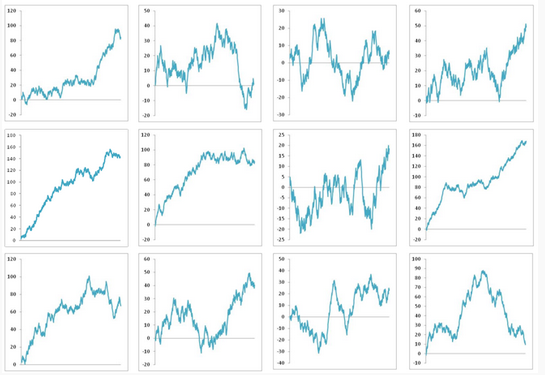The Luck factor in Sports Betting
Luck plays a very important role in the outcome of our betting activity, much more than many think. It’s true that in the long term the influence of luck tends to zero and the more bets we make the less it will affect our results. But in the short terms luck can have an amazing influence, for better or worse.
Most of tipsters and regular bettors know what I am talking about. Anyone who bets regulary has experienced sharp trends in his profit curve, although we use to blame “luck” only when things are moving in the wrong direction and not when we are on fire.
In order to see, from a mathematical perspective, how luck can influence our results, we have made a Monte Carlo simulation. Let’s consider a hypothetical good bettor that would have achieved a 10% yield in a very high number of bets and we can consider this 10% yield his long term “edge” over the market. He makes 400 more bets. These are the parameters:
- Number of bets in 1 year: 400
- Odds: 2.20 (we assume all bets are made at these odds)
- Strike rate: 50%
- Fixed stake: 2 units/bet
- ROI or yield: 10% = (0.50 x (-2) + 0.50 x 2 x 1.20) / 2
- Initial bankroll: 100 units
For ease of calculations, we have used a Fixed Bankroll bankroll management; that is, a 2 units fixed stake is always used. This is how the Monte Carlo simulation works: Excel gives us 400 random numbers between 0 and 1. As the strike rate is 50%, if the number is lower than 0.50 we consider it a lost bet and if the number is higher than 0.50 it’s a won bet. In the first case we lose 2 units and in the second one we win 2.40 (2 x 1.20). This is how the bettor achieves that 10% long term yield. With 400 random numbers we can generate a profit line like the ones we can see below:

This is a sample of 12 results, achieved during a year. We can see that in several of them the magnitude of the bad runs is really sharp, even though in all cases the 10% yield bettor gets to finish the year in profit. Now we carry out this simulation not 12 but 1,000 times. With such a high number of samples we can already obtain very rigurous figures from a statistical point of view. The “maximum drawdown” (maximum peak to trough decline in the period) is 82 units (82% of the initial bankroll) and the average of all drawdowns is 30.9 units. That is, the bankroll of a very good bettor like this one suffers maximum drawdowns of 30.9% on average in a year, using a 2% stake. If we raise it to 3%, the average max. drawdown would be 46.5% and if we get crazy and make 5% our fixed stake the average drawdown would be 77.5%!! Moreover, as we raise the stakes, the number of simulations where we lose all our bankroll and we go bankruptc obviously grows.
The conclusion is that even for a bettor who is able to generate significant profits in the long term, luck plays a key role in the short term evolution of his bankroll. A bad run will come sooner or later and we should use a sound money management strategy so that the bankruptcy risk won’t be high. Apart from the value we perceive in each of our bets, the staking strategy should obviously be very connected with the odds size. Taking low odds we can risk higher stakes and viceversa.




Muy interesante la Simulación de Montecarlo para conocer a priori según ciertos parámetros nuestros resultados probables-posibles. Tengo alguna duda al respecto del artículo. Nos dice según los parámetros expuestos el máximo drawdown y la media de los mismos según el % de stake medio,pero, ¿la media de beneficios esperado y el máximo de beneficios esperado que arroja la simulación para conocer todos los datos de la estrategia cuales serían? ¿Y con un stake medio al 3% y al 5%, tal y cómo se hace en el ejemplo que medias de beneficios podríamos esperar dado esos datos? ¿Podríais ponerlo a modo de ejemplo para orientarnos, por favor? Muchas gracias y un saludo.
Hola Saúl,
El beneficio esperado con un stake medio de 2 unidades es 10% de 8400 x 2) = 80 unidades, 80% de rentabilidad
Si el stake medio es de 3 unidades, el beneficio esperado es de 10% de (400 x 3) = 120 unidades, 120% de rentabilidad
Con stake 5 el beneficio es de 200 unidades, 200% de rentabilidad.
Estamos asumiendo un bankroll inicial de 100 unidades y una estrategia de gestión de bankroll fijo.
Muchas gracias Daniel así queda mucho más claro todo y podemos determinar hasta que punto queremos asumir ciertos riesgos. Una cosa más, tal y como pone en el post podemos esperar un drawdown promedio y un máximo drawdown dados ésos parámetros. Mi pregunta es: ¿Éste drawdown lo podríamos esperar una vez en esa muestra, o más veces en la misma muestra? Si por ejemplo tuviésemos 1000 o 10.000 apuestas, ¿cómo podríamos calcular las veces que se producirá ese drawdown esperado o máximo en esa muestra de 1000 o 10.000 apuestas? Es importante saberlo para adoptar una estrategia adecuada que contemple éstas circunstancias. Gracias y un saludo.
Me parece un artículo muy interesante. El cerebro humano no está preparado para comprender la aleatoriedad y busca patrones donde no los hay.
Si además, varías los stakes, las probabilidades de acierto y el número de picks en un determinado periodo de tiempo, el lío ya es considerable y hay que hacer análisis como el que muestras para evaluar los resultados.
Te planteo una pregunta: ¿Qué ocurre con el beneficio y el DD si hacemos que la cantidad apostada sea directamente proporcional a la banca después de cada apuesta?
Gracias Miguel.
En el caso que comentas el riesgo disminuye y por tanto el drawdown máximo. Pero es muy complejo hacer simulaciones con banca variable.
Saludos
Creo que la gestión de los stakes es un tema tan básico y importante que debería estar destacadísimo en pyckio, de forma que a nadie le pasara por alto. Y no solo por responsabilidad moral, sino porque si hay mucha gente apostando cada vez un 10%-20% de su bankroll a los picks de un PRO a quien sigue, en poco tiempo va a quedarse sin nada, va a dejar de ser cliente de Pyckio y encima va a hablar mal de él injustamente.
Por otro lado quería comentar que me parece raro que se tengan tanto en cuenta los stakes fijos por criteros estadísticos y que pesen tan poco en el algoritmo de rating de pyckio, que creo que se tendría que repasar. Que sea posible ganar cantidades astronómicas en pocos picks con stakes muy altos y luego bajar a stake 1 para mantener un rating que está fuera de lugar a lo mejor se tendría que revisar. Hay gente que puede estar perdiendo dinero a causa de ello y la reputación del sitio se ve afectada.
I really need this